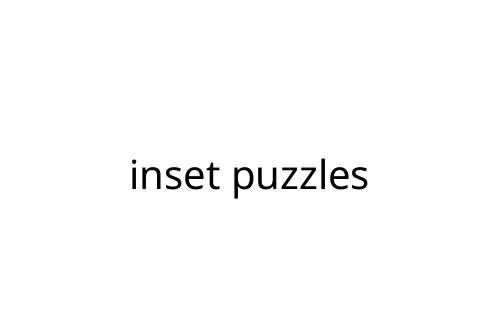inset puzzles
Inset puzzles are a staple in early childhood education, and for good reason. These basic puzzles, typically made from wood or thick plastic, feature pieces that fit into corresponding cut-out spaces on a board. Each slot is designed for a specific shape, letter, animal, or object. They’re often some of the first puzzles children encounter.
Why Inset Puzzles Work
Inset puzzles are effective because they encourage hands-on learning. The design ensures each piece has only one correct home. This simplicity helps young children practice coordination, hand strength, and spatial reasoning skills. For toddlers, the process of gripping, turning, and placing each piece is valuable fine motor work.
Since images on the puzzle base match the pieces, children get clear visual feedback. This strengthens shape and image recognition. Many inset puzzles also feature themes like numbers, vehicles, or animals, introducing basic concepts in a playful way.
Benefits and Drawbacks
Pros:
- Immediate feedback when pieces fit makes learning intuitive.
- Durable construction withstands rough play.
- Range of designs suits different age groups and educational goals.
- Encourages independence and confidence, since kids can often complete them solo.
Cons:
- Simpler puzzles can become too easy quickly, so kids may age out fast.
- Limited challenge means older kids won’t stay engaged for long.
- Some puzzles are bulky, which can make storage tricky.
Choosing the Right Inset Puzzle
When shopping for inset puzzles, pay attention to age recommendations. For infants, look for chunky pieces with easy-to-grasp knobs. Older toddlers can handle smaller pieces with more intricate cutouts.
Check material quality. Wooden inset puzzles are sturdy, but plastic options are lightweight and sometimes dishwasher-safe. Safe, non-toxic finishes matter, especially for pieces that might end up in a child’s mouth.
Consider themes that match the child’s interests, whether animals, farm life, numbers, or vehicles. The more engaged the child, the more learning will sneak in.
Inset Puzzles for Learning and Play
These puzzles aren’t just for solo play. Caregivers can use them as a springboard for conversation: “What sound does this animal make?” or “Can you find the red truck?” This promotes descriptive language and early vocabulary. Some inset puzzles pair with activities like matching colors, counting, or storytelling.
For occupational therapists, inset puzzles are a reliable tool for assessing and developing motor skills. They also encourage patience and problem-solving.
Are Inset Puzzles Worth It?
In short: yes, especially for younger children. Inset puzzles offer foundational skills in a play-driven format. They won’t entertain a child forever — but at the right stage, they’re a smart, simple tool for hands-on development. The best approach is to start with basic designs, then gradually move to more challenging puzzles as skills grow. Rotate puzzles to keep interest fresh, and don’t be surprised if that favorite animal-shaped piece sees a lot of action.


 Christina Alvardo is the author of Rush Gambler Win, a premier platform for staying ahead in the dynamic world of gambling. Renowned for her expertise, Christina delves into a wide range of topics, including casino games, sports betting, esports wagering, and the exciting realm of cryptocurrency gambling. Through her in-depth knowledge and practical advice, she offers players expert tips, strategies, and insights to enhance their gameplay, make smarter bets, and ultimately improve their chances of success. Whether you’re a seasoned gambler or a newcomer, Christina’s content ensures you stay informed and ahead of the curve.
Christina Alvardo is the author of Rush Gambler Win, a premier platform for staying ahead in the dynamic world of gambling. Renowned for her expertise, Christina delves into a wide range of topics, including casino games, sports betting, esports wagering, and the exciting realm of cryptocurrency gambling. Through her in-depth knowledge and practical advice, she offers players expert tips, strategies, and insights to enhance their gameplay, make smarter bets, and ultimately improve their chances of success. Whether you’re a seasoned gambler or a newcomer, Christina’s content ensures you stay informed and ahead of the curve.
